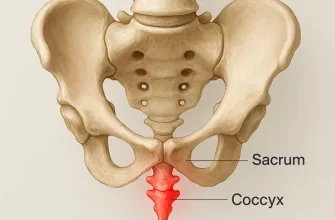If you have ever had pain in the area between your shoulder blades, you understand how uncomfortable and bothersome it can be. However, what exactly leads to this kind of pain? Let us examine what pain between the shoulder blades entails and some of the typical causes.
Causes
Interscapular pain, also known as pain between the shoulder blades, refers to any discomfort or ache felt in the area connecting the spine and the shoulder blades. The severity of this pain can vary from mild to severe and it can be constant or happen periodically.
Pain between the shoulder blades can be caused by various factors. One frequent culprit is having bad posture. Sitting or standing in a slouched position for a prolonged time can strain the muscles and ligaments in the upper back, resulting in discomfort. Moreover, working in an office or driving without adequate back support can also contribute to experiencing this kind of pain.
Another frequent reason for pain between the shoulder blades is muscle strain. Engaging in tasks that require lifting heavy objects, performing repetitive motions, or making sudden twists and turns can lead to the upper back muscles being stretched or torn, causing discomfort.
In some cases, pain between the shoulder blades may be a symptom of a more serious underlying condition. These can include:
- Herniated disc: Pain can be caused when the discs that provide cushioning between the vertebrae in the upper back are damaged or bulge, leading to pressure on surrounding nerves.
- Osteoarthritis: Pain between the shoulder blades can be caused by a degenerative joint disease that impacts the upper back.
- Gallbladder issues: Pain in the back, particularly in the region between the shoulder blades, can be attributed to issues with the gallbladder, such as gallstones or inflammation.
- Heart-related problems: If you have pain between your shoulder blades, it may indicate a heart attack or angina in certain situations. It is crucial to seek medical help if you encounter chest pain or any discomfort combined with shoulder blade pain.
Symptoms Associated with Pain Between the Shoulder Blades
Although shoulder blade pain is potentially caused by various factors, particular symptoms can indicate specific underlying conditions. If you are experiencing pain between your shoulder blades, it is important to be aware of the following additional symptoms that may occur:
- Radiating arm pain: If you feel uneasy in the region between your shoulder blades and also experience pain extending down your arm, it may suggest a pinched nerve in your neck or a slipped disk. These ailments can also cause feelings of pins and needles, lack of sensation, or reduced strength in your arm.
- Difficulty breathing: If you feel any discomfort in-between your shoulder blades along with difficulty in breathing or a feeling of not being able to breathe properly, it could be a sign of an issue with your lungs or the middle area of your spine. It is crucial to seek medical assistance if you experience this symptom.
- Chest pain: Sometimes, pain that occurs between the shoulder blades may be mistaken for chest pain that starts from the heart. If you also feel any discomfort, tightness, or pressure in the chest, it is extremely important to promptly seek medical help in order to eliminate the possibility of any heart-related problems.
- Neck stiffness: If you observe inflexibility or restricted movement in your neck as well as discomfort in your shoulder blades, it may signal a strained neck muscle or a problem with your cervical spine. The root causes could be related to hunching, muscle imbalances, or the deterioration of the spinal column.
- Headaches: Persistent pain in the area between the shoulders could lead to headaches, particularly tension headaches that cause a dull, throbbing feeling. Tense muscles in the neck and shoulders may also play a role in these types of headaches.
- Nausea or vomiting: Shoulder blade pain, accompanied by nausea or vomiting, is not as frequent, but it can be indicative of a digestive disorder like gallbladder disease or gallstones, particularly if the discomfort is felt on the right side.
- Abdominal pain: If you experience abdominal pain along with the discomfort in the area between your shoulder blades, it may suggest a possible problem affecting the organs in your abdomen, such as pancreatitis or peptic ulcers. It is advised to seek medical help if this symptom persists.
Treatment
There are a few methods you can attempt to relieve discomfort in the area between the shoulder blades. These include:
- Maintaining good posture: Maintain a proper seated or standing position by ensuring your shoulders are pulled back and your back is upright, avoiding any tendency to hunch or slouch.
- Stretching exercises: Engaging in regular stretching exercises can alleviate muscle tension in the upper back and help prevent strains.
- Applying heat or ice: Using a heating pad or ice pack on the impacted region can aid in reducing swelling and offering momentary alleviation.
- Over-the-counter pain relievers: Medications like ibuprofen, which fall under the category of nonsteroidal anti-inflammatory drugs (NSAIDs), have the ability to alleviate pain and reduce inflammation.
If the discomfort continues or gets worse, it is essential to seek advice from a medical expert to receive an accurate diagnosis and specific treatment. They might suggest physical therapy, chiropractic manipulations, or other measures to target the root cause of your pain in the area between your shoulder blades.
Prevention
- Maintain good posture: Incorrect posture is a major reason why people experience pain in the area between their shoulder blades. Slumping or bending forward can create pressure on the muscles and joints in this region, resulting in uneasiness. It is important to be aware of your stance throughout the day and make a deliberate attempt to maintain an upright position with relaxed shoulders.
- Stretch regularly: Integrating consistent stretching into your daily routine can effectively avert discomfort in the area between your shoulder blades. Prioritize stretching the muscles in your upper back and shoulders to alleviate stress and enhance your overall flexibility. Basic activities such as shoulder rolls, doorway stretches, and upper back stretches can have a significant impact and bring about positive changes.
- Strengthen your upper back: Developing a robustness in the muscle groups surrounding the shoulder blades is beneficial in terms of maintaining support and decreasing the chances of encountering discomfort. Engaging in exercises such as rows, reverse flyes, and pull-ups helps to specifically target these muscles, and they can be conveniently integrated into your regular workout regimen. Strive to allocate two to three workout sessions per week for optimal progress.
- Take breaks from sitting: Sitting for long periods can contribute to muscle stiffness and tension in the upper back. Make a habit of taking breaks from sitting every hour or so. Stand up, stretch, and walk around to help relieve any accumulated pressure. Additionally, consider investing in an ergonomic chair or using a cushion to support your back while sitting.
- Avoid heavy backpacks or bags: Carrying a heavy backpack or bag on one shoulder can place strain on the muscles between the shoulder blades. Opt for a backpack with two shoulder straps and distribute the weight evenly across your back. Alternatively, use a crossbody bag or a bag with a wide, padded strap to minimize stress on the upper back.
- Adjust your sleeping position: The manner in which you rest during sleep can also play a role in causing discomfort between your shoulder blades. If you typically sleep on your stomach, you could consider changing to resting on your back or side, using a pillow for added support. Opt for a pillow that maintains proper alignment of your head and neck with your spine, in order to prevent excessive strain on your upper back.
- Exercise and stay active: Engaging in regular physical activity is beneficial for both our overall wellbeing and the development of strong and flexible muscles, including those located in the upper back. It is recommended to have a well-rounded exercise routine that incorporates cardiovascular activities, strength training, and flexibility exercises. By doing so, we can enhance our posture, decrease tension, and prevent discomfort between the shoulder blades.
- Apply heat or cold therapy: If you feel discomfort in the area between your shoulder blades, you can alleviate it by applying heat or cold. You can use a heating pad, warm compress, or take a warm shower to help relax the muscles. On the other hand, you can also apply an ice pack or a cold compress wrapped in a thin towel to reduce inflammation and numb the affected area.
By adhering to these prevention strategies, you can greatly decrease the chances of encountering discomfort in the area between your shoulder blades. It is important to pay attention to your body and consult a medical professional if the pain continues or worsens. By taking proactive measures to look after your upper back, you will enhance your overall wellbeing and enjoy a more pleasant quality of life.









